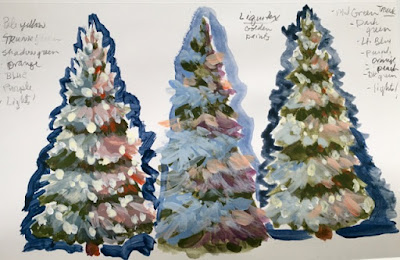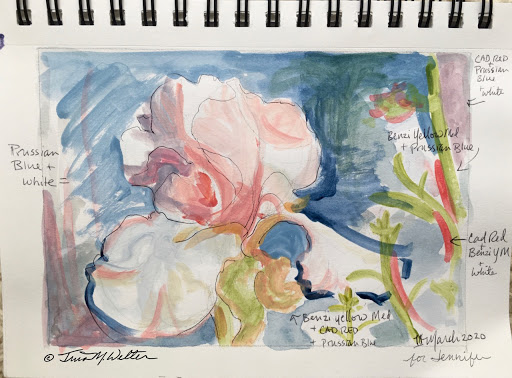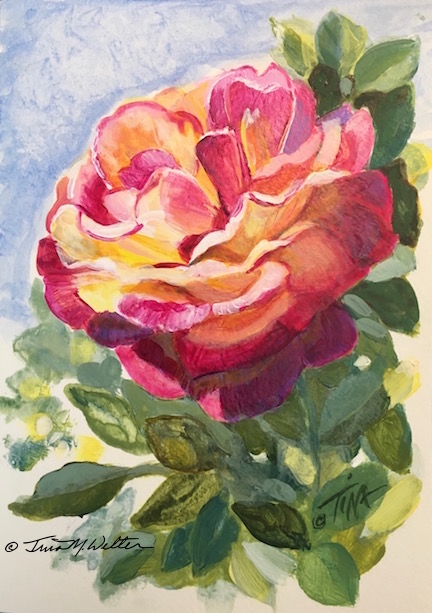 |
| "December Evening" |
One positive aspect of dealing with a pandemic is that it pushes people to be creative in connecting with each other.
In November, one of my friends asked if I would try teaching a short mini-class on painting using the App, Marco Polo. Instead of sending texts, this app allows people to leave videos for each other. I've often wondered what it would be like to teach a painting class, so I decided to give it a try.
 |
| Tiny Sketch, 2 x 2.5 inches |
I chose a lighted Christmas tree outside with a twilight sky as our subject. Simple, right? Just one triangle shape with a dark background and some lights, how hard could it be…and so began my innocent journey into the thick of the woods.
 |
| Tiny Sketch 1.5 x 2.25 inches |
I’ve never actually broken down my painting methods into steps so that someone else could follow me before, and I soon found that taking apart what I do was quite the challenge.
Figuring out the palette is often my first and favorite step, but this time I also had to think about palette colors that would be really common to find and versatile for beginning painters to use.
 |
| Cadmium Red, Cadmium Yellow, Ultramarine Blue, Titanium White |
I painted a couple of sketches using the basic colors of Cadmium Red, Cadmium Yellow, Ultramarine blue, and Titanium White. Then I went on-line and looked for paint sets that would include those colors, but many used Cobalt blue instead of Ultramarine blue and the red and yellow were listed as “primary” colors. Goodness, what should to tell people to buy?
 |
| Painting Sketch, 5x7 inches, using Cobalt blue. |
This led me to make more sketch paintings using Cobalt blue to see if it that color would work instead. Soon I found myself down a whole color theory rabbit-hole, testing out “color bias” combinations of warm red, yellow and blue compared to using a set of cool red, yellow and blue. This topic deserves a whole blog post of it’s own.
 |
| Warm biased palette. |
 |
| Cool biased palette. |
My biggest concern being that my initial palette choice was wrong and would make painting harder for other people because I used a “cool” blue with a “warm” red and yellow. Seriously, this kept me up at night and I wasn’t happy until I had tested all the options. It turned out that I still liked that initial palette best after all, even if it didn’t follow the “color bias” theory. Well, that is creativity, sometimes breaking the rules makes the best art.
 |
| Pine Tree Basics |
Next, was breaking down the drawing. One friend said she could barely draw a circle, so I told her not to worry because we would be making triangles! I measured and marked every shape so that I could explain how to get the tree and it’s branches placed correctly.
Since we were only using red, yellow and blue, I made one video on color mixing. I was amazed that it took 40 minutes to explain and my poor iPhone got really hot doing all that recording!
Then, it was the painting steps. Goodness, I think I made three or four sketch paintings to make certain I could explain and show everything in order. Yes, I wrote the steps down, I needed those reminders for when I actually made the final video.
 |
| Figuring out the steps! |
As a side note, I believe that some of the quick, tiny sketches I threw together are much better paintings than the larger sketches I spent a lot of time making. It is annoying to me that I have a hard time capturing that spontaneity in larger artwork.
 |
| Tiny Sketch, 1 x 1.5 inches |
I did feel the pressure when making the final painting on camera, it was an odd feeling to be watched while doing something that has always been a solo project. Overall, I'm pleased with how the video and painting turned out, although the next day I could see the blue shadows should have been darker on the snow. So far, I have resisted the urge to repaint that section.
I've certainly gained an appreciation for all the extra work those artists I grew up watching on t.v. must have done to make painting on camera look so easy. A respectful bow to Bob Ross, Bill Alexander and Helen Van Wyck!
Happy Creating!
>^-^<
Tina
































